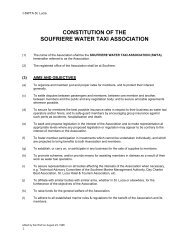WWF Cover photo - Soufriere Marine Management Association ...
WWF Cover photo - Soufriere Marine Management Association ...
WWF Cover photo - Soufriere Marine Management Association ...
Create successful ePaper yourself
Turn your PDF publications into a flip-book with our unique Google optimized e-Paper software.
Community monitoring is working well. People are really enthusiastic about the work and keen to see results oftheir management. Tawake and Aalbersberg (2001) of the University of the South Pacific did a parallel study ofinvertebrate numbers at the same sites as community researchers were assessing. They found no significantdifferences in the data obtained, confirming that the community monitoring was of the same quality as ascientific study conducted by outside experts. However, university scientists assisted with data analyses whichthe community found more difficult. The scientists felt an important part of their contribution was regular returnvisits to the communities to follow up training, monitoring and data analyses. The local monitoring team and theuniversity scientists make regular reports to village and district meetings, so that the results can be used in futuremanagement decisions. Local monitoring of reserve effects contributes greatly to the autonomy of themanagement area, and is also much more likely to continue in the long term if it becomes part of the routinewithin the community. Communities are also more likely to respond to monitoring results they have collectedthemselves and therefore trust, rather than when they are only shown the findings of studies conducted byexternal researchers. Community monitoring encouraged people to improve their compliance with the closedarea, and initial compliance problems diminished and the community were also motivated to protect the areafrom poachers. The location of the closed area directly in front of the village allows it to be policed moreeffectively.Monitoring showed a dramatic increase in the numbers and size of clams in the closed area after three years ofprotection, and an increase in the numbers of smaller clams recruiting to fished areas (Figure 2). Clams began togrow bigger than had been seen for three generations. People had hardly ever seen clams of more than 6cm, butbegan to find individuals up to 9cm. After four years of management, clams had increased in abundance by1353% in the closed area and by 523% in the fished area. Catch per unit effort increased and people only neededto spend half the time they normally spent collecting clams to get the same catch as before (Tawake andAalbersberg 2001). The most recent data collected in 2002 shows that after 5 years of protection there have beenfurther increases in clam abundance. Clams are now 1796% more abundant in the closed area and 719% moreabundant in the fished area (Ucunivanua community and A. Tawake unpublished data). Because of theirsedentary lifestyle and their pelagic larval stage, molluscs like clams might be expected to respond particularlywell to management using closed areas.Number of clams80 April 199770August 200060504030201006Clam size in cmNumber of clams807060504030201006Clam size in cmApril 1997September 2000Figure 2: The number of clams (Anadara sp.) counted in 50 1m 2 quadrats in eachsize class in the closed area (top) and in the adjacent fished area (bottom) in 1997when the closed area was established, and in 2000 after 3 years of protection.Data collected by the Ucunivanua Monitoring Team and reproduced with theirpermission. From Tawake et al. 2001.61



